The NVIDIA GeForce GTX 780 Ti Review
by Ryan Smith on November 7, 2013 9:01 AM ESTCompute
Jumping into compute, we’re entering the one area where GTX 780 Ti’s rule won’t be nearly as absolute. Among NVIDIA cards its single precision performance will be unchallenged, but the artificial double precision performance limitation as compared to the compute-focused GTX Titan means that GTX 780 Ti will still lose to GTX Titan whenever double precision comes into play. Alternatively, GTX 780 Ti still has to deal with the fact that AMD’s cards have shown themselves to be far more competitive in our selection of compute benchmarks.
As always we'll start with our DirectCompute game example, Civilization V, which uses DirectCompute to decompress textures on the fly. Civ V includes a sub-benchmark that exclusively tests the speed of their texture decompression algorithm by repeatedly decompressing the textures required for one of the game’s leader scenes. While DirectCompute is used in many games, this is one of the only games with a benchmark that can isolate the use of DirectCompute and its resulting performance.
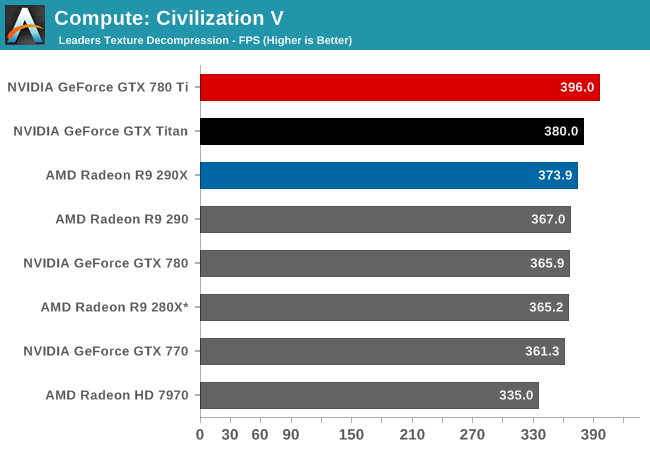
Even though we’re largely CPU bound by this point, GTX 780 Ti manages to get a bit more out of Civilization V’s texture decode routine, pushing it to the top of the charts and ahead of both GTX Titan and 290X.
Our next benchmark is LuxMark2.0, the official benchmark of SmallLuxGPU 2.0. SmallLuxGPU is an OpenCL accelerated ray tracer that is part of the larger LuxRender suite. Ray tracing has become a stronghold for GPUs in recent years as ray tracing maps well to GPU pipelines, allowing artists to render scenes much more quickly than with CPUs alone.
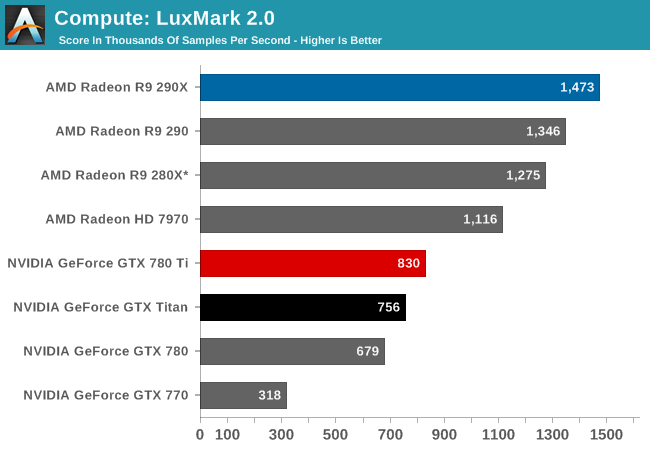
With LuxMark NVIDIA’s ray tracing performance sees further improvements due to the additional compute resources at hand. But NVIDIA still doesn’t fare well here, with the GTX 780 Ti falling behind all of our AMD cards in this test.
Our 3rd compute benchmark is Sony Vegas Pro 12, an OpenGL and OpenCL video editing and authoring package. Vegas can use GPUs in a few different ways, the primary uses being to accelerate the video effects and compositing process itself, and in the video encoding step. With video encoding being increasingly offloaded to dedicated DSPs these days we’re focusing on the editing and compositing process, rendering to a low CPU overhead format (XDCAM EX). This specific test comes from Sony, and measures how long it takes to render a video.

Like LuxMark, GTX 780 Ti once again improves on its predecessors. But it’s not enough to make up for AMD’s innate performance advantage in this benchmark, leading to GTX 780 Ti trailing all of the AMD cards.
Our 4th benchmark set comes from CLBenchmark 1.1. CLBenchmark contains a number of subtests; we’re focusing on the most practical of them, the computer vision test and the fluid simulation test. The former being a useful proxy for computer imaging tasks where systems are required to parse images and identify features (e.g. humans), while fluid simulations are common in professional graphics work and games alike.
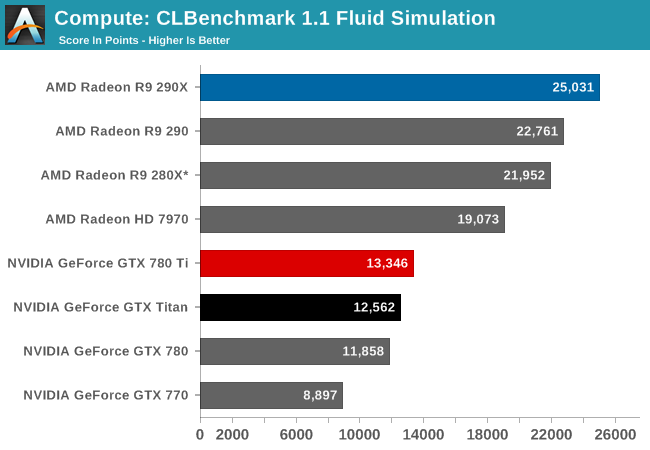
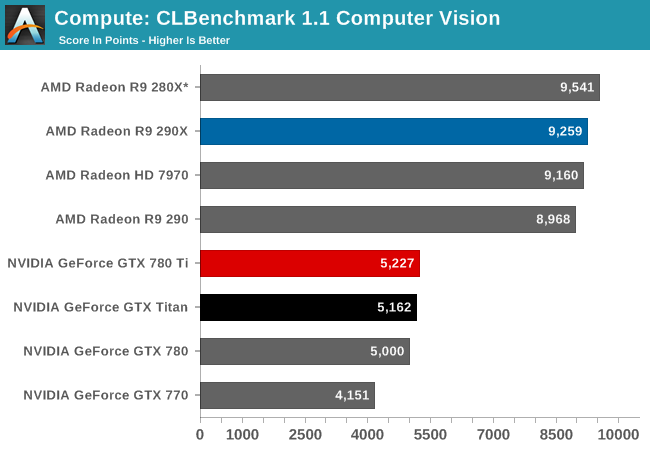
CLBenchmark continues to be the same story. GTX 780 Ti improves on NVIDIA’s performance to become their fastest single precision card, but it still falls short of every AMD card in these tests.
Moving on, our 5th compute benchmark is FAHBench, the official Folding @ Home benchmark. Folding @ Home is the popular Stanford-backed research and distributed computing initiative that has work distributed to millions of volunteer computers over the internet, each of which is responsible for a tiny slice of a protein folding simulation. FAHBench can test both single precision and double precision floating point performance, with single precision being the most useful metric for most consumer cards due to their low double precision performance. Each precision has two modes, explicit and implicit, the difference being whether water atoms are included in the simulation, which adds quite a bit of work and overhead. This is another OpenCL test, as Folding @ Home has moved exclusively to OpenCL this year with FAHCore 17.

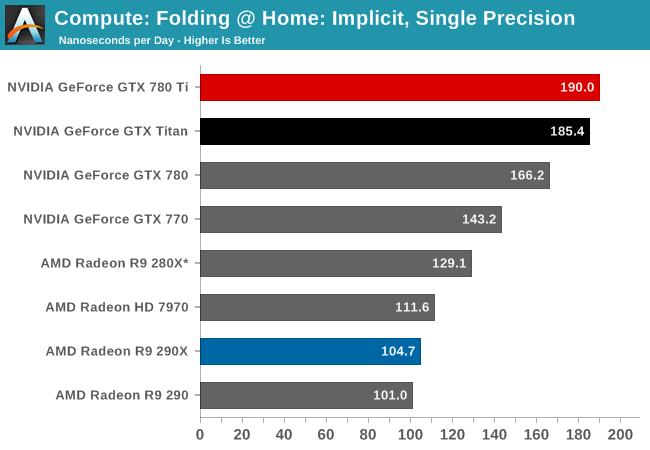
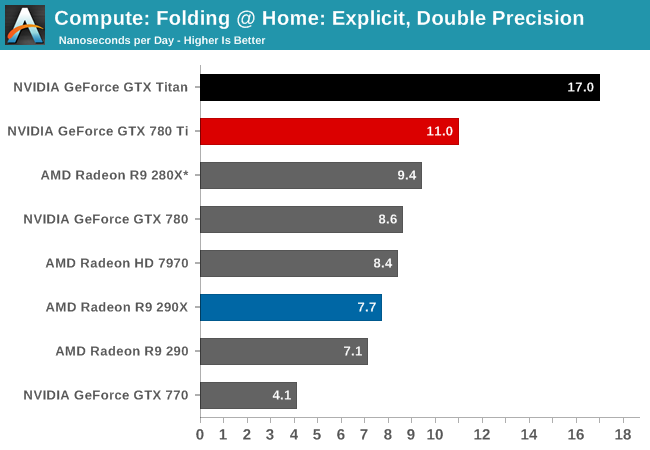
Finally with Folding@Home we see the GTX 780 Ti once again take the top spot. In the single precision tests the GTX 780 further extends NVIDIA’s lead, beating GTX Titan by anywhere between a few percent to over ten percent depending on which specific test we’re looking at. However even with GTX 780 Ti’s general performance increase, in the double precision test it won’t overcome the innate double precision performance deficit it faces versus GTX Titan. When it comes to double precision compute, Titan remains king.
Wrapping things up, our final compute benchmark is an in-house project developed by our very own Dr. Ian Cutress. SystemCompute is our first C++ AMP benchmark, utilizing Microsoft’s simple C++ extensions to allow the easy use of GPU computing in C++ programs. SystemCompute in turn is a collection of benchmarks for several different fundamental compute algorithms, as described in this previous article, with the final score represented in points. DirectCompute is the compute backend for C++ AMP on Windows, so this forms our other DirectCompute test.
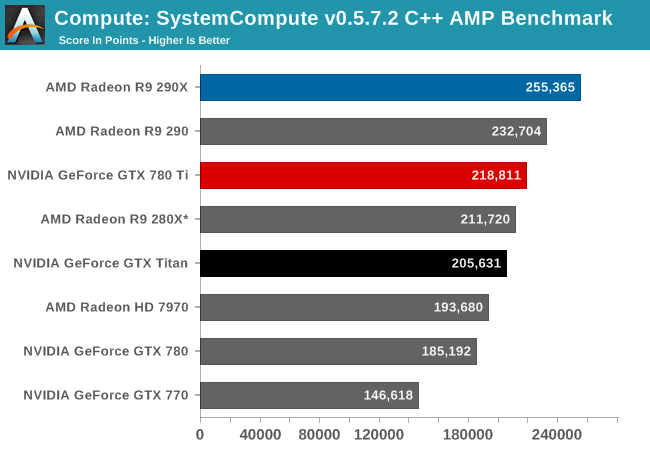
Last, in our C++ AMP benchmark we see the GTX 780 Ti take the top spot for an NVIDIA card, but like so many of our earlier compute tests it will come up short versus AMD’s best cards. This isn’t quite as lopsided as some of our other tests, however GTX 780 Ti is stuck competing with the 280X while the 290 and 290X easily outperform NVIDIA’s new flagship.










302 Comments
View All Comments
polaco - Friday, November 8, 2013 - link
Indeed that's exactly the way I see it. AMD has played it's cards quite well this time. NVidia seems to be on it's price knees and can't compete any way. NVidia needs a new GPU to compete with Hawaii. I don't want to put into cosideration Mantle, TrueAudio, Gsync nor the Shield discount.Mantle and TrueAudio hasn't been demoed yet.
Shield seems like a waste of money and almost useless for me.
Maybe in a future if they prove to be worthy we will see Mantle, TrueAudio and Gsync to be included as part of an upgrade other standards.
Gigaplex - Sunday, November 10, 2013 - link
Only 5% faster than a $1000 card? Yeah, totally overpriced at $700.Sarcasm aside, it really is overpriced. But comparing it to the Titan to justify that claim doesn't work.
polaco - Friday, November 8, 2013 - link
Well looking at Anand's benchmarks I can't find a way to justify spending such amount of money on this card. AMD 290 and 290X looks way more interesting. As difference to others reviews Anand's has focused only in ultra high resolutions I think that's the way to go. Since no one would buy one of this cards (780ti, 290X) to game at 1680x1050. So at this high resolutions performances differences between the cards are barely minimal in most cases and could be reduced even more by drivers updates or settings tunning. I find no reason to spend such a difference for 780 Ti while having more than decent performance from radeon 290 at 250 bucks less. If I would want to go to an extreme instead of aquiring a 780Ti it would be better and get 2xradeon290 for 100 bucks more. So the problem of 780Ti is it's price, pure and simple. I really find difficult NVidia could lower the prices more since it looks 290 and 290X launch has putted NVidia prices to it's knees. So far I'm still waiting for 290, 290X third party coolers if they are good they can even pair or overcome 290 and 290X performance against 780Ti. What I have no doubt is how Titan and 780 early buyers must be feeling at this moment...j6z7 - Friday, November 8, 2013 - link
I think the majority of comments here reveals the truth behind big headlines with reviews.The reference 290X with 10 year old reference cooler still beating the 780ti with best cooler in CF - and it does it being $300 cheaper too!
If anything, Nvidia shot itself in the foot against its own Titan.
Nvidia fans will continue to support the company in ripping people off, while AMD provides same performance at affordable prices.
End of the day, people who'll buy the 290X will be much more satisfied customers.
The End.
Mondozai - Friday, December 13, 2013 - link
Nvidia fanboys like EJS1980 are like battered wives. They are trying to rationalize themselves being raped.b3nzint - Friday, November 8, 2013 - link
You must be pissed with 290x being priced that low. Anyway AMD should reconsider for using that blower type fan. Nvidia have better cooling system than AMD, but for that price i just don't care. For $700? still too much.b3nzint - Friday, November 8, 2013 - link
what about mantle, compute power and trueaudio? u don't buy gpu for just friggin fps number!wwwcd - Friday, November 8, 2013 - link
WoW Ryan cut my comment. I know he is a really hard green fen, but this censor not placed with democracy. I can revenge of m-r Anand!Ryan Smith - Friday, November 8, 2013 - link
Uh, we haven't deleted anything. Are you sure you haven't just misplaced your comment?not_there - Friday, November 8, 2013 - link
I'm not a gamer, but I like to put a decent video card in my builds to run Folding@Home. It's real science and it helps heat my basement. Reading the reviews here I'm confused (someone point out what I'm missing). In a June review of the GTX 760 the Radeon HD 7970 got a 36.1 and in this review, the same card on the same test got a 29.3. This was the Folding@Home Explicit, Single Precision benchmark. June number for the GTX 770 in this test was 35.6 and in the same test on the same card in this review the benchmark is 15.1. Why the difference?